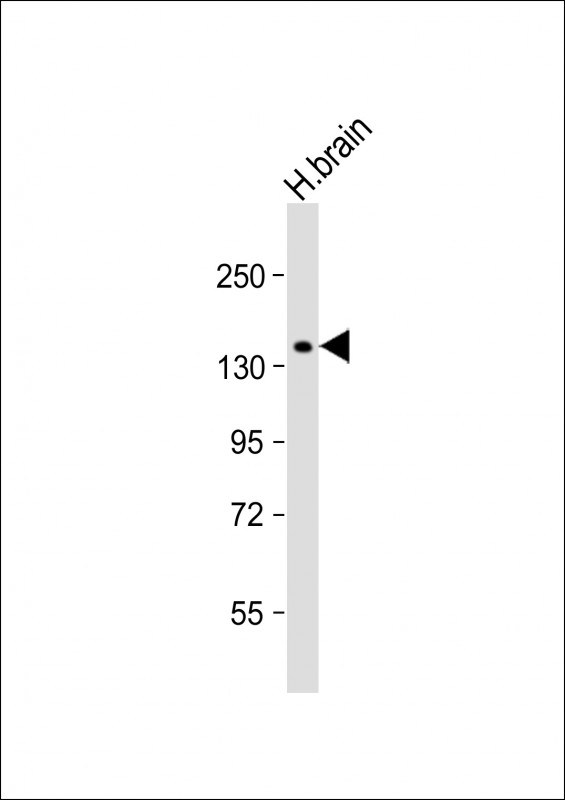MTMR4 Antibody (Center)
Affinity Purified Rabbit Polyclonal Antibody (Pab)
- 产品详情
- 实验流程
- 背景知识
Application
| WB, E |
|---|---|
| Primary Accession | Q9NYA4 |
| Other Accession | NP_004678.3 |
| Reactivity | Human |
| Host | Rabbit |
| Clonality | Polyclonal |
| Isotype | Rabbit IgG |
| Calculated MW | 133353 Da |
| Antigen Region | 695-723 aa |
| Gene ID | 9110 |
|---|---|
| Other Names | Myotubularin-related protein 4, FYVE domain-containing dual specificity protein phosphatase 2, FYVE-DSP2, Zinc finger FYVE domain-containing protein 11, MTMR4, KIAA0647, ZFYVE11 |
| Target/Specificity | This MTMR4 antibody is generated from rabbits immunized with a KLH conjugated synthetic peptide between 695-723 amino acids from the Central region of human MTMR4. |
| Dilution | WB~~1:1000 E~~Use at an assay dependent concentration. |
| Format | Purified polyclonal antibody supplied in PBS with 0.09% (W/V) sodium azide. This antibody is purified through a protein A column, followed by peptide affinity purification. |
| Storage | Maintain refrigerated at 2-8°C for up to 2 weeks. For long term storage store at -20°C in small aliquots to prevent freeze-thaw cycles. |
| Precautions | MTMR4 Antibody (Center) is for research use only and not for use in diagnostic or therapeutic procedures. |
| Name | MTMR4 (HGNC:7452) |
|---|---|
| Function | Lipid phosphatase that specifically dephosphorylates the D-3 position of phosphatidylinositol 3-phosphate and phosphatidylinositol 3,5-bisphosphate, generating phosphatidylinositol and phosphatidylinositol 5-phosphate (PubMed:11302699, PubMed:16787938, PubMed:20736309, PubMed:27625994, PubMed:29962048, PubMed:30944173). Decreases the levels of phosphatidylinositol 3-phosphate, a phospholipid found in cell membranes where it acts as key regulator of both cell signaling and intracellular membrane traffic, in a subset of endosomal membranes to negatively regulate both endocytic recycling and trafficking and/or maturation of endosomes toward lysosomes (PubMed:16787938, PubMed:20736309, PubMed:29962048). Through phosphatidylinositol 3-phosphate turnover in phagosome membranes regulates phagocytosis and phagosome maturation (PubMed:31543504). By decreasing phosphatidylinositol 3-monophosphate (PI3P) levels in immune cells it can also regulate the innate immune response (PubMed:30944173). Beside its lipid phosphatase activity, can also function as a molecular adapter to regulate midbody abscission during mitotic cytokinesis (PubMed:25659891). Can also negatively regulate TGF-beta and BMP signaling through Smad proteins dephosphorylation and retention in endosomes (PubMed:20061380, PubMed:23150675). |
| Cellular Location | Early endosome membrane; Peripheral membrane protein. Recycling endosome membrane; Peripheral membrane protein. Late endosome membrane; Peripheral membrane protein. Cytoplasmic vesicle, phagosome membrane; Peripheral membrane protein |
| Tissue Location | Expressed in brain, heart, kidney, spleen, liver, colon, testis, muscle, placenta, thyroid gland, pancreas, ovary, prostate, skin, peripheral blood, and bone marrow |
For Research Use Only. Not For Use In Diagnostic Procedures.
Provided below are standard protocols that you may find useful for product applications.
BACKGROUND
Dephosphorylates proteins phosphorylated on Ser, Thr, and Tyr residues and low molecular weight phosphatase substrate para-nitrophenylphosphate. Phosphorylates phosphatidylinositol 3,4,5-trisphosphate (PIP3).
REFERENCES
Yu, J., et al. J. Biol. Chem. 285(11):8454-8462(2010) Dolley, G., et al. Mol. Genet. Metab. 97(2):149-154(2009) Plant, P.J., et al. Biochem. J. 419(1):57-63(2009) Colland, F., et al. Genome Res. 14(7):1324-1332(2004) Zhao, R., et al. Exp. Cell Res. 265(2):329-338(2001)
终于等到您。ABCEPTA(百远生物)抗体产品。
点击下方“我要评价 ”按钮提交您的反馈信息,您的反馈和评价是我们最宝贵的财富之一,
我们将在1-3个工作日内处理您的反馈信息。
如有疑问,联系:0512-88856768 tech-china@abcepta.com.























 癌症的基本特征包括细胞增殖、血管生成、迁移、凋亡逃避机制和细胞永生等。找到癌症发生过程中这些通路的关键标记物和对应的抗体用于检测至关重要。
癌症的基本特征包括细胞增殖、血管生成、迁移、凋亡逃避机制和细胞永生等。找到癌症发生过程中这些通路的关键标记物和对应的抗体用于检测至关重要。 为您推荐一个泛素化位点预测神器——泛素化分析工具,可以为您的蛋白的泛素化位点作出预测和评分。
为您推荐一个泛素化位点预测神器——泛素化分析工具,可以为您的蛋白的泛素化位点作出预测和评分。 细胞自噬受体图形绘图工具为你的蛋白的细胞受体结合位点作出预测和评分,识别结合到自噬通路中的蛋白是非常重要的,便于让我们理解自噬在正常生理、病理过程中的作用,如发育、细胞分化、神经退化性疾病、压力条件下、感染和癌症。
细胞自噬受体图形绘图工具为你的蛋白的细胞受体结合位点作出预测和评分,识别结合到自噬通路中的蛋白是非常重要的,便于让我们理解自噬在正常生理、病理过程中的作用,如发育、细胞分化、神经退化性疾病、压力条件下、感染和癌症。






